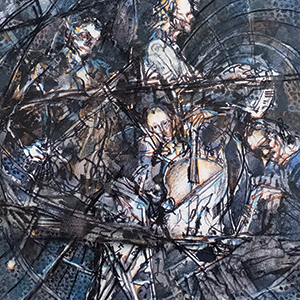Arts
Anno Domini's Quartet for
the End of Time
 ART IS HARD: Illustrator Barron Storey was inspired to create TK after listening to Olivier Messiaen's 'Quartet for the End of Time,' which the composer wrote while in a Nazi POW camp.
ART IS HARD: Illustrator Barron Storey was inspired to create TK after listening to Olivier Messiaen's 'Quartet for the End of Time,' which the composer wrote while in a Nazi POW camp.
Composer Olivier Messiaen wrote and premiered his Quartet for the End of Time as a war prisoner inside Stalag VIII-A, near Görlitz, Germany, in what's now Poland. Rather than attempting escape, Messiaen devoted all his spare energy to the piece—playing piano and enlisting other POWs to play clarinet, violin and cello.
The work debuted in January 1941. Many experts situate the quartet near the top of 20th-century chamber music, not only for the catastrophic circumstances surrounding its inception, but also for Messiaen's reverent Catholic faith, his use of medieval modes and Hindu rhythmic cycles, and his disregard for all sense of linear time. While other musicians in the camp plotted to escape, Messiaen chose to stay and write music in response to his conditions.
This weekend, renowned graphic illustrator Barron Storey will debut artwork inspired by Quartet for the End of Time at cAnno Domini. San Jose-based cellist Freya Seeburger, currently analyzing the quartet for her master's thesis at SFSU, will preview some of the music and talk about her research. In addition, her own quartet will perform the entire piece on Feb. 20 at 8pm, Mar. 12 at 8pm and Mar. 13 at 2pm.
Storey and Seeburger came together via the Anno Domini exhibit. At 75, Storey draws inspiration from dark, disquieting subjects. Two previous Anno Domini shows in particular tackled the horrors of the Iraq war, and, in another instance, the brutal platform of suicide. Neither exhibit was even remotely comfortable to view. Seeburger, on the other hand, is less than half of Barron's age and is trying to graft her analysis of Messiaen's quartet onto a conversation about the San Jose arts scene.
"The piece really fits for me because I'm a very emotional guy," Storey says, adding that no matter what prevailing tastes exist in music or in art, emotion is what fuels his work. War and suicide were subjects that resonated with him emotionally, as does Messiaen's quartet. "I'm not really that fond of the whole 'art market' reality," he says. "But I do want to express things that are felt about the interface between art and emotion."
Part of the story behind the Quartet for the End of Time involves the sympathy of the German guards who supplied Messiaen with pencils and staff paper. Since Messiaen was also an ornithologist, the guards allowed him to wake up early and notate the melodies of birds, which then became passages in the quartet. Messiaen's dedication to his art in the face of confinement is part of what inspires Storey and Seeburger.
"There's one thing to come up with a tone system like Schoenberg's that provides a rebellion against classical structures," Storey says. "It's another thing to just do something as obvious as not only paying attention to or being inspired by birdsong, but actually going out in a forest and copying down birdsong note for note. He's on record as saying that the birds are the greatest musicians that have ever appeared on planet Earth. A pretty esoteric idea."
Seeburger recently returned from Europe, where she visited the former Stalag VIII-A, performed on location and even recorded the nearby birds. Call it field research, just part of the process of combining history, theory and practice. Ultimately, it's a very difficult piece to play, she says, with borderline-impossible virtuosic passages, but a fun piece to become one with and experience. It redefines the artist's relationship with the audience and her circumstances.
"The piece, for me, represents an intersection of aesthetics, of politics and of musical technique," Seeburger says. "It's groundbreaking in its technical innovation, it's amazing as a response to the historical circumstances, it lends itself to all the platforms we talk about, with the complexities of war, and how staggering and horrifying war is."
In Storey's case, we will see his definitive anti-formalist technique, some of which slips into cartoon or illustration. Much of the show explores the decisions between accepting confinement or dedicating oneself to escape. "I'm not just expressing," Storey says. "I'm, in a way, documenting."
Anno Domini is open Tue-Fri, 12pm-7pm; Saturday, 12pm-5pm.
Quartet for the End of Time
Feb. 5, 12pm, Free
Anno Domini, San Jose


